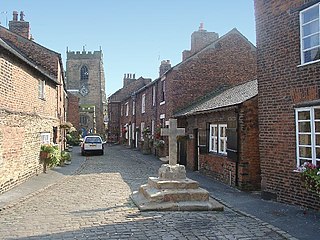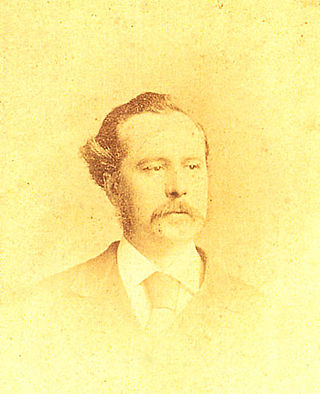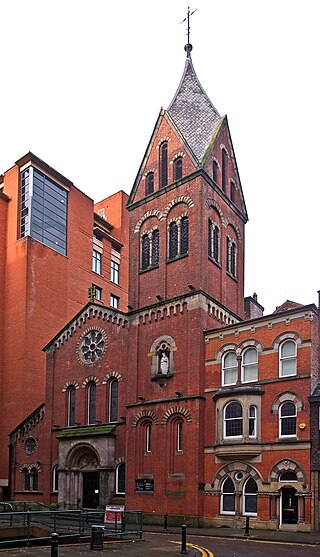
Augustus Welby Northmore Pugin was an English architect, designer, artist and critic with French and Swiss origins. He is principally remembered for his pioneering role in the Gothic Revival style of architecture. His work culminated in designing the interior of the Palace of Westminster in Westminster, London, and its renowned clock tower, the Elizabeth Tower, which houses the bell known as Big Ben. Pugin designed many churches in England, and some in Ireland and Australia. He was the son of Auguste Pugin, and the father of Edward Welby Pugin, Cuthbert Welby Pugin, and Peter Paul Pugin, who continued his architectural and interior design firm as Pugin & Pugin.

Ormskirk is a market town in the West Lancashire district of Lancashire, England. It is located 13 miles (21 km) north of Liverpool, 11 miles (18 km) northwest of St Helens, 9 miles (14 km) southeast of Southport and 18 miles (29 km) southwest of Preston. Ormskirk is known for its gingerbread. In 2011 it had a population of 24,073.

Scarisbrick is a village and civil parish in West Lancashire, England. The A570, the main road between Ormskirk and Southport, runs through Scarisbrick, and much of the village lies along it. As a result, it does not have a traditional village centre, though the junction with the A5147 is close to the geographic centre.

The Hub is a public arts and events building in the centre of Edinburgh, Scotland. Located at the top of the Royal Mile, it is a prominent landmark as its tall Gothic spire is the highest point in central Edinburgh, and towers over the surrounding buildings below Edinburgh Castle.

Cotton College was a Roman Catholic boarding school in Cotton, Staffordshire, United Kingdom. It was also known as Saint Wilfrid's College.

Rufford is a village in West Lancashire, England, where the Leeds and Liverpool Canal, Liverpool, Ormskirk and Preston Railway, the A59 and the River Douglas meet.

Augustus Charles Pugin was an Anglo-French artist, architectural draughtsman, and writer on medieval architecture. He was born in Paris, then in the Kingdom of France, but his father was Swiss, and Pugin himself was to spend most of his life in England.

Croston is a village and civil parish near Chorley in Lancashire, England. The River Yarrow flows through the village. The population of the civil parish taken at the 2011 census was 2,917.

Edward Welby Pugin was an English architect, the eldest son of architect Augustus Welby Northmore Pugin and Louisa Barton and part of the Pugin & Pugin family of church architects. His father was an architect and designer of Neo-Gothic architecture, and after his death in 1852 Edward took up his practice. At the time of his own early death in 1875, Pugin had designed and completed more than one hundred Catholic churches.

The Hidden Gem, officially St Mary's Catholic Church, is a church on Mulberry Street, Manchester, England. The parish dates back to 1794, with devotion to St Mary, Our Lady of the Assumption, and the present church, rebuilt in 1848, is a Grade II*-listed building which includes the Diocesan Shrine of Our Lady of Manchester.

Alton Castle is a Gothic-revival castle, on a hill above the Churnet Valley, in the village of Alton, Staffordshire, England. The site has been fortified in wood since Saxon times, with a stone castle dating from the 12th century. The current castle was constructed in the mid-19th century by John Talbot, 16th Earl of Shrewsbury, of nearby Alton Towers. Since 1967 the castle has been designated a Grade I listed building. It is also a scheduled monument.

The architecture of Manchester demonstrates a rich variety of architectural styles. The city is a product of the Industrial Revolution and is known as the first modern, industrial city. Manchester is noted for its warehouses, railway viaducts, cotton mills and canals – remnants of its past when the city produced and traded goods. Manchester has minimal Georgian or medieval architecture to speak of and consequently has a vast array of 19th and early 20th-century architecture styles; examples include Palazzo, Neo-Gothic, Venetian Gothic, Edwardian baroque, Art Nouveau, Art Deco and the Neo-Classical.

The Church of St Peter and St Paul is in the market town of Ormskirk, Lancashire, England. Dating from no later than the 12th century, it is one of only three churches in England to have both a tower and spire, and the only one to have them both at the same end of the church. It is an active Anglican parish church in the Diocese of Liverpool. The church is recorded in the National Heritage List for England as a designated Grade II* listed building.

John Norton was an English architect who designed country houses, churches and a number of commercial buildings.

Scarisbrick Hall School is a mixed private school, located in Scarisbrick Hall, Lancashire, England, that educates children from nursery to age 18.

St Augustine's Church or the Shrine of St Augustine of Canterbury is a Roman Catholic church in Ramsgate, Kent. It was the personal church of Augustus Pugin, the renowned nineteenth-century architect, designer, and reformer. The church is an example of Pugin's design ideas, and forms a central part of Pugin's collection of buildings in Ramsgate. Having built his home, Pugin began work on St Augustine's in 1846 and worked on it until his death in 1852. His sons completed many of the designs. This is the site where Pugin is buried, in a vault beneath the chantry chapel he designed, alongside several members of his family.
Scarisbrick is a civil parish in the West Lancashire district and borough of Lancashire, England. It contains 32 buildings and structures that are recorded in the National Heritage List for England as designated listed buildings. Of these, one is listed at Grade I, the highest of the three grades, and the others are at Grade II, the lowest grade. The most significant building in the parish is Scarisbrick Hall which is listed at Grade I, with several associated structures being listed separately. The parish is a collective of smaller hamlets and is largely rural. Many of the listed buildings are houses, farmhouses or other agricultural buildings that have since been repurposed as dwellings, while the others include a telephone kiosk and the Roman Catholic Church of St Elizabeth.

St Mark's Church stands on the corner of Southport Road and Jacksmere Lane in Scarisbrick, Lancashire, England. Built in 1848–51, it is an active Anglican parish church in the deanery of Ormskirk, the archdeaconry of Warrington, and the diocese of Liverpool. The parish and benefice includes The Good Shepherd Mission, a tin chapel also located in Scarisbrick on Smithy Lane.
The history of the Palace of Westminster began in the Middle Ages – in the early eighth century – when there was an Anglo-Saxon church dedicated to St. Peter the Apostle which became known as the West Minster. In the tenth century the church became a Benedictine abbey and was adopted as a royal church, which subsequently became a royal palace in the 11th century.

St Mary's Church is a Roman Catholic parish church in Stockton-on-Tees, County Durham, England. It was built in 1842 and designed by Augustus Pugin in the Gothic Revival style. According to Historic England, the current building was first permanent Roman Catholic church to be built in Teesside since the Reformation. It is located in the town centre, on the corner of Norton Road and Major Street, with the A1305 road to the north of it. It is a Grade II listed building.


























